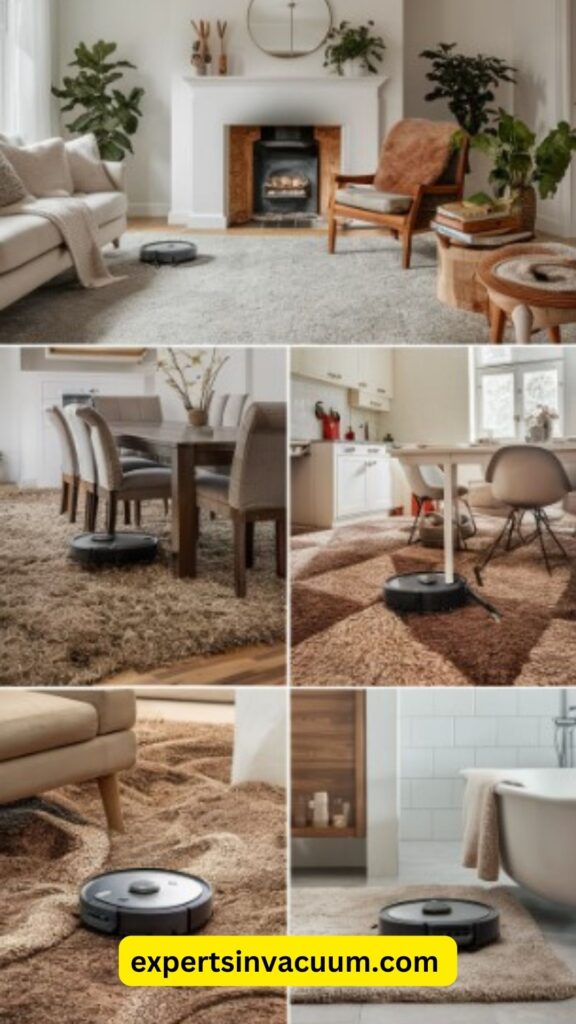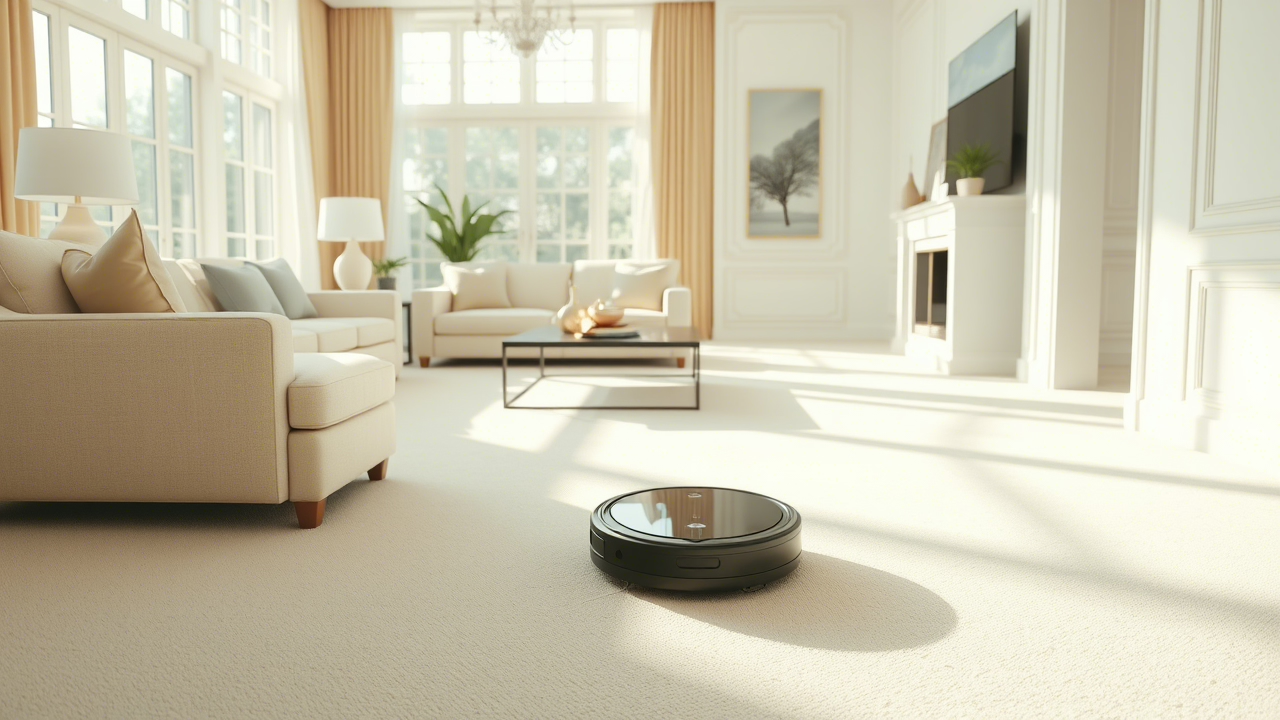Tired of pushing heavy vacuums over thick carpets?
A robot vacuum for thick carpet makes cleaning easier, faster, and hands-free.
It handles deep fibers with powerful suction and smart movement.
Keep your floors fresh with less effort and enjoy more free time where it matters most—home.
Robot Vacuum for Thick Carpet: Clean Without the Hassle
1. Choose One With High Suction Power
Thick carpets trap dirt deep down.
A robot vacuum with at least 2500 Pa of suction can pull debris from beneath dense fibers.
This prevents buildup and helps maintain the texture and color of your carpet over time.
The stronger the suction, the more efficiently it handles pet hair, dust, and crumbs.
2. Make Sure It Has Large Wheels
Robot vacuums often struggle with thick or shaggy piles if the wheels are too small.
Look for one with large, rugged wheels that lift the body higher off the floor.
This helps the vacuum glide over soft surfaces smoothly without getting stuck or tangled in fibers.
3. Opt for Height-Adjusting Sensors
Some robot vacuums automatically raise or lower themselves depending on the surface.
This is ideal for homes with a mix of thick carpet and hard floors.
Height-adjusting sensors allow a smoother transition and better suction contact, which keeps both surfaces properly cleaned.
4. Check for Tangle-Free Brush Rolls
High-pile carpets love to eat hair, string, and fuzz.
A tangle-free brush roll helps prevent clogging and reduces the need for daily cleaning.
Silicone or rubberized brush designs are more resistant to jams and ideal for homes with pets or long-haired family members.
5. Go for Smart Navigation
Random path cleaners might repeatedly bump around thick carpets or miss spots entirely.
A robot vacuum with smart mapping and LiDAR scans your layout for efficient route planning.
It remembers carpet-heavy zones and works in straight, thorough lines for complete coverage.
6. Pick a Model With Carpet Boost Mode
Carpet boost mode automatically increases suction when a robot senses carpet underfoot.
This feature is especially helpful on thick rugs and wall-to-wall carpeting.
It keeps performance strong without draining the battery too quickly or wasting energy on smooth surfaces.
7. Use a Robot With Strong Battery Life
Thick carpets slow down robot vacuums and drain power faster.
Choose a vacuum with at least 100 minutes of runtime or one that resumes cleaning after recharging.
That way, your whole carpet gets cleaned even if the vacuum has to pause and recharge midway.
8. Schedule Regular Cleaning
Consistency is key. Thick carpets should be vacuumed at least 3–4 times per week.
Most robot vacuums let you schedule cleanings via app or voice control.
Set it and forget it—your carpet will always look fresh without daily manual effort.
9. Choose Multi-Level Mapping If You Have Stairs
Some homes have thick carpeting across multiple floors.
A robot with multi-level mapping remembers each floorplan and saves the layout, so you don’t have to reprogram it every time.
Just carry it upstairs, hit start, and let it handle the rest.
10. Clean the Filters Weekly
Thick carpets produce more dust and shed more fibers than low-pile ones.
Your robot vacuum’s filter can clog faster, reducing suction.
Clean or replace filters weekly to keep performance high and prevent allergies caused by trapped particles recirculating in the air.
11. Use Boundary Strips or No-Go Zones
To keep your robot off delicate shag areas or avoid cords hiding in thick rugs, use magnetic boundary strips or set digital no-go zones.
This keeps your vacuum focused on easy-to-navigate sections and helps avoid getting stuck or confused mid-task.
12. Check the Dustbin Size
Thick carpets produce more fuzz, so your dustbin fills up faster.
Go for a robot vacuum with a large-capacity bin or self-emptying base.
You won’t need to stop mid-clean to empty it, and it can clean more in one go without losing suction power.
13. Keep Carpets Clutter-Free
Robot vacuums don’t work well around clutter.
Keep thick carpets clear of socks, cables, toys, or loose threads that could trip the vacuum.
This helps it work faster and safer, without dragging small objects across the room or getting caught.
14. Pair With a Handheld for Edges
Even the best robot vacuums struggle with corners and deep edges of high-pile carpets.
Use a handheld vacuum for a quick pass along the edges once a week.
This fills in the gaps and keeps every inch of your carpet looking spotless.
15. Test on Small Areas First
Before running your robot vacuum across your entire carpet, test it in a corner.
Watch how it handles transitions, climbs over thicker sections, and whether it gets stuck.
This helps you understand its limits and make any adjustments before full use.
FAQs
1. Can robot vacuums damage thick carpets?
No, as long as you choose one designed for high-pile carpets.
Models with soft brush rolls and adjustable suction are carpet-safe and effective without causing wear.
2. Do all robot vacuums work on thick rugs?
Not all do. Basic models often struggle with thick fibers.
Look for one labeled for “high-pile” or “thick carpet” to avoid getting stuck or skipping areas.
3. How often should I vacuum thick carpets with a robot vacuum?
Aim for at least 3–4 times per week.
Daily cleaning is best if you have pets or allergies to keep carpets fresh and free of embedded dirt.
The Wind-Up
Robot vacuums make thick carpet cleaning far easier, if you choose the right model and features.
From powerful suction to smart mapping, investing in a high-performance unit saves time and keeps carpets fresh.
Don’t forget to pair it with regular care for best results.
Want more cleaning tips and carpet care hacks? Check out our latest posts on robot vacuums.

